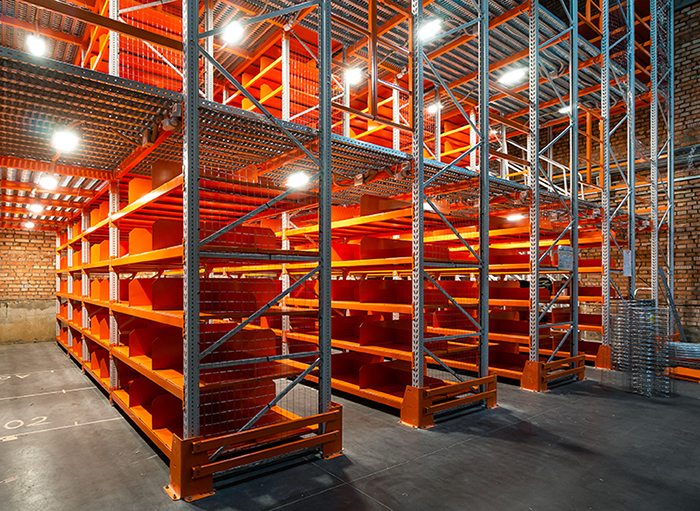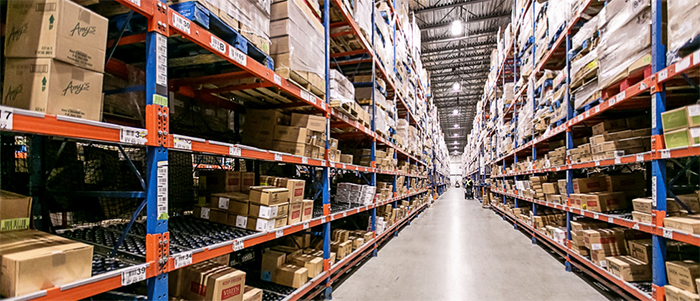Racks, Shelving and Automation: Options for Effective Storage
The differences between rack and shelves go further than size and capacity

Warehouse racks and industrial shelving are sort of like alligators and crocodiles: they look alike, they do similar things, and they are often mixed up. Both are vertical structures that have horizontal shelves for industrial storage. But they aren’t the same thing–they have distinctive missions and functions. Most warehouses use both types of storage for various types of loads, and there are gray areas where either can be used, depending on the storage strategy. Knowing the differences can help you store your inventory more efficiently and effectively.
The primary differences between rack and shelving
Loading & access methods
Most shelving is loaded and accessed by hand, and most rack is loaded and accessed by machinery. However, there are important exceptions to this rule. Some bulk shelving can hold over 1,000 pounds, which can result in the need for bulk unloading. Some racks that hold large containers or pallets can be hand-accessed for picking. Sometimes, there are gray areas where specifying the right storage equipment based on access will save significant money and make the process easier.
Shelving tends to be designed precisely for hand access, which tends to make it the best choice for any manually accessed material, while rack is superior for bulk and unit storage.
Decking or shelves
Shelving tends to have a solid surface for its loads to rest on, but many racks support their loads on beams or arms without any decking at all. Because shelves are hand-accessed, it makes sense to have surfaces that allow bins or cartons to slide along them, on and off the shelves. Racks, on the other hand, can be loaded by forklifts so that their loads are lifted off or hoisted on. Since their loads can be larger and structurally more rigid, they often don’t need decking (although there are times they do, and decks can be added easily to most rack systems).
Capacity and load characteristics
Shelving usually can’t hold the heavy weights a rack system does. It isn’t as heavy, isn’t as bulky and isn’t as stable beneath extremely heavy loads.
Regulations and permitting
Racks and shelves can fall under different code standards. For instance, selective racks tend to fall under ANSI MH16.1 standards. Boltless (rivet) shelving is regulated by ANSI MH28.2, while steel (bin) shelves are subject to ANSI MH28.1. These standards can help decide what type of equipment you should use in a particular function.
Shelving: the factors
Retail shelving isn’t industrial–no matter what they call it
The sort of shelving you see at home improvement stores isn’t viable for industrial applications. Retail shelving looks like industrial shelving, but lacks the required beefy construction, heavier components, engineering and capacities. It isn’t meant to store those kinds of demanding loads, and isn’t designed for frequent access. Even for lightweight loads like small parts, shelf integrity and stability are critical for successful storage systems. That means heavier, better-built shelving.
How is shelving different from racking?
- Shelving is always hand loaded and unloaded. People can pick from it and restock it with muscle power. If you’re loading it with a forklift, it’s not shelving.
- Capacity: shelves can be heavy-duty, but not as heavy as racking. Higher-capacity rivet shelving holds weights up to 1,500 pounds per shelf. That’s a lot, but it’s sort of where racks get started. They can hold extremely heavy weights, and are built to access those large items.
- Shelving offers more customization. Accessories for customization and flexibility are available. Bins, dividers, drawers and lots more. Racks offer some of these items, but not as many or as specialized.
- Anchors aren’t always required. Almost all racks must be anchored into concrete for safe operations, but most shelving applications do not require anchors.
- It isn’t as dimensionally large as racks. Shelving can be relatively large, but nothing like a rack unit. Since it’s usually hand-accessed, it usually isn’t taller than a person unless another access method is used. Since people reach into the shelves, its depth is more limited. It is plenty deep for bulk storage (up to 48″), so it has the ability to store things like records or components in fairly dense configurations. Those deeper units are often placed center of a double aisle, so they can be accessed from both sides.
- Shelving has solid decks. It supports its loads with a full deck beneath them, where pallet and cantilever racks often support the load with beams or arms and no decking.
Read more: Industrial shelving tips and information
Shelving types
The range of shelving types allows both generalized and specialized storage functions. Usually, it’s understood that shelving is hand-loaded and lighter than racks, but there are gray areas even by that definition. Shelving tends to be freestanding, but can be integrated into shelf-supported mezzanines for high-density storage and picking.
Steel shelving: versatility and customization options galore

Above: bin shelving with tight vertical space for maximum storage efficiency
The most versatile type, with more options and accessories for customized storage. It can have extremely tight shelf spacing that lets you store smaller parts bins in a few inches of vertical space. It’s more labor intensive to install than boltless/rivet shelving, and tends to focus on picking, accessories and storage density. You can fit steel shelving with modular drawers, dividers, spacers and more.
Rivet shelving: the most economical for bulk industrial storage

Boltless shelving is the most economical for general industrial storage. It’s heavy-duty with high capacities and the easiest to install. It can also be dimensionally larger than steel or wire shelves, in some instances becoming an alternative to bulk racks. It’s frequently used as mezzanine or catwalk support in pick modules. Its decking is usually 5/8″ particle board, although steel or wire decks are available. Rivet shelves are almost always accessible from both sides, where steel shelves often have back braces or support that limits that access to one side.
Wire shelving: great looks, good for cold storage, many types of customization

Wire shelves have the best aesthetic look of all shelving types. It’s used in commercial and clean applications more frequently than general warehouse storage, and is very easy to assemble and adjust. It’s a good option for refrigerated or cold storage. Its open deck design doesn’t stop air flow, gather much dust or impede sprinkler systems. It’s often configured with casters for mobility.
Widespan bulk shelving: extremely heavy capacities and larger dimensions for manual access

This hybrid system uses beefy uprights and beams similar to selective pallet racks. It’s ideal for hand-loaded, medium to heavy duty loads. It’s frequently integrated into mezzanines and platforms, and offers the largest dimensional sizes in the shelving class, with widths up to 96″, heights to 144″ and depths to 48″. Wide span has many deck options, depending on application and stored products.
Mobile aisle shelving systems: built-in storage density and space utilization

Mobile aisle shelving puts the emphasis on space utilization and is best used in tight areas, where floor space is needed for other functions and density is the key. You can fit them with a variety of shelving types, racks, modular drawers, cabinets and more. Almost any kind of shelving design can be placed onto a mobile aisle system. See mobile shelving FAQ.
Racks: the factors
How are racks different from shelving?
Most operations will load racking with a machine such as a forklift, crane or shuttle cart. Some racks are loaded by hand, such as lighter cantilever racks or pallet racks, item picks from pallets, carton flow inserts and other means.
- Racks are usually loaded and unloaded by machine. You tend to need forklifts to pull full pallets off a rack, but people also pick cartons or eaches off pallets.
- Capacities are heavier. The heaviest shelving isn’t on par with the lightest pallet racking.
- Racks are built differently, with heavy beams and uprights rather than posts and shelves.
- Anchoring is required for most rack types. Racks are heavier, taller, wider and carry beefier loads. They need to be anchored on a stable floor for stability and safety.
Rack types
Because they store a more diverse range of loads, there are many kinds of warehouse racks.
Pallet racks: heavyweight pallet, container and bulk storage

Above: Pallet racks, particularly selective rack, are frequently and incorrectly called shelving.
Selective pallet rack is the most common type. It stores a single pallet facing an aisle so you can pick every pallet at all times. Double-deep racks are similar to selective, but allow you to store two pallets deep in a selective configuration. Drive-in racks are space-efficient, with last-in, first-out access for a single SKU per bay. Pallet flow racks store a single SKU per bay and level in a first-in, first-out storage strategy and great storage density.
Pallet racks are often the structural basis for high-density storage platforms, pick modules or entire buildings. It’s frequently fitted with carton flow for each-picks and carton picks.
Automated pallet storage systems

This range of storage options includes unit-load AS/RS, which stores pallets in deep rack structures and retrieves them with mobile cranes. Pallet shuttle systems use shuttles that run on rail systems to store and access pallets in a deep rack structure.
Cantilever racks
Cantilever racks are ideal for storing furniture, pipe, lumber, tubing and other long loads. They’re usually machine-loaded except in lighter-duty manual racks or in some retail or assembly operations involving long, light items.
Cantilever racks can be built with cranks and rollers for easier access and storage density.
Other industrial rack types

This range of racks includes stacking racks, sheet metal storage racks, racks for spools and roll-out racking. These kinds of racks are often accessed with balancers or hoists, but can be loaded or unloaded by hand, depending on the load type and operation.
Read more
- Specifying Bins and Containers for Storage – Cisco-Eagle
- The Difference Between Racking And Shelving – MHI
- Pallet Racks Selectivity vs. Storage Density – Cisco-Eagle
Scott Stone is Cisco-Eagle's Vice President of Marketing with 35 years of experience in material handling, warehousing and industrial operations. His work is published in multiple industry journals an websites on a variety of warehousing topics. He writes about automation, warehousing, safety, manufacturing and other areas of concern for industrial operations and those who operate them.



